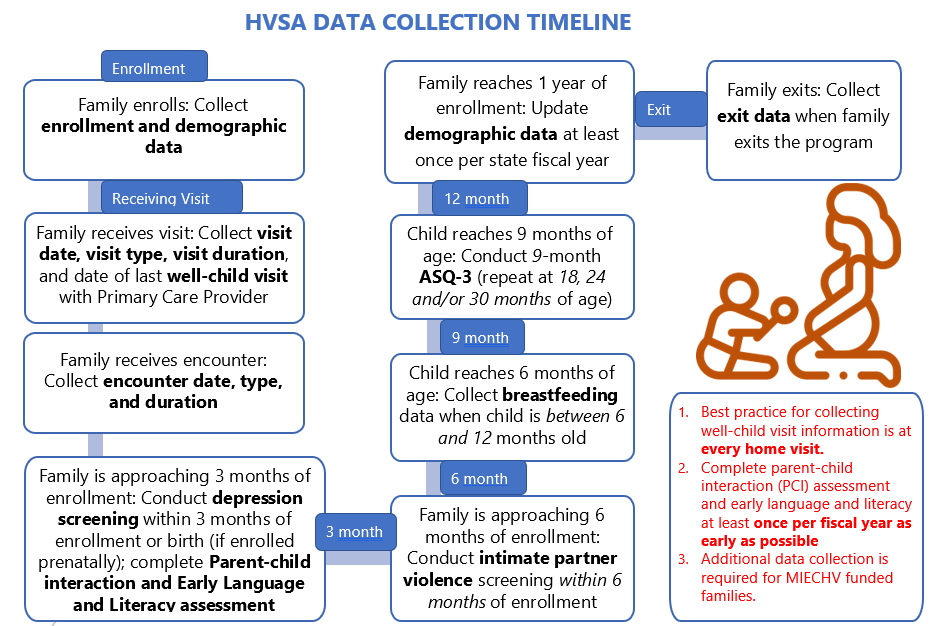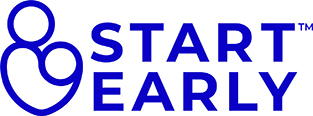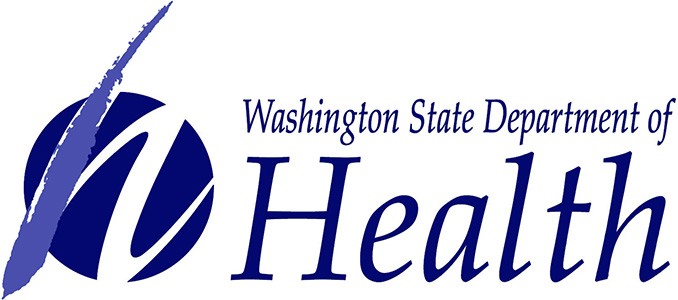An important role of the Home Visiting Services Account (HVSA) is to monitor and evaluate the implementation and outcomes of home visiting services supported by the HVSA and provided by the local implementing agencies (LIAs). Understanding who is being served, their experiences, and the impact of home visiting services for these families provides important information for assuring the right services are reaching the right communities.
LIAs that receive HVSA funds must collect data for all enrolled HVSA families that satisfy model and HVSA data requirements. Programs that receive Maternal Infant & Early Childhood Home Visiting (MIECHV) funding are required to report on additional MIECHV measures. Programs may report additional data on performance payment milestones to receive incentive payments. These data fall into five categories:
- Enrollment and Service Utilization
- Demographic Characteristics
- HVSA Aligned Performance Measures
- MIECHV Performance Measures
- Performance-Based Contracting Milestones
There are additional data collection requirements necessary to meet model fidelity, which are not covered here. Please consult model guidance for appropriate reporting procedures.
There are a few data collection and reporting best practices to keep in mind:
- Complete data entry into your data system within five business days of data collection. This minimizes incomplete reporting and ensures that data is available for sharing with the Washington State Department of Health (DOH) at the close of the reporting period.
- All demographic data from families should be self-reported by the caregivers, not assumed by the home visitors.
- Every family supported by HVSA funds must have a funding code assigned at enrollment. If an HVSA funding code is not assigned, then the family will not be included in any reporting from the HVSA and will not be considered served by the HVSA.
The following information serves as an HVSA data collection and reporting manual. Each section includes a general overview of the topic and links to materials that support data collection and reporting, such as instructions for entering data into the Flo and Visit Tracker data systems, just-in-time training videos, sample forms, and assessment tools.
For questions about HVSA reporting, email HomeVisiting@doh.wa.gov.
For questions about HVSA contracts, email home.visiting@dcyf.wa.gov.
LIAs are tasked with collecting data which satisfies both model and HVSA requirements for all enrolled HVSA families. The process for sharing data across the HVSA is complex. First, the LIAs enter participant data into their local or national data system. These data are then shared with DOH either through monthly extracts from model data systems (Daisy, FLO, and Visit Tracker) or through quarterly data submissions shared via Managed File Transfer (MFT) accounts. DOH consolidates the data, calculates performance measures, and produces various reports that are shared with LIAs, DCYF, and other home visiting partners. The information generated from these data supplied by the families supports DCYF in responding to legislators, funders, and advocates of home visiting, providing data to tell the home visiting story in Washington.
Steps to Sharing Data
Step 1
First, there needs to be an executed contract in place between the LIA and DCYF, with a Data Attachment that identifies all the data reporting requirements.
Step 2
DOH will next establish a contractual Data Sharing Agreement (DSA) with the new LIA. This DSA details the expectations for data sharing, security, and protections that cover the sharing of participant data between the LIA, DOH, and DCYF.
Step 3
Once the DSA has been executed, DOH will set up an MFT account for the LIA to use for sharing data and reports between the LIA and DOH.
Get more information on accessing and using the MFT:
- Managed File Transfer (MFT) Instructions (PDF)
- Managed File Transfer Just-in-Time Training (video) - Coming soon
Step 4
The LIA will identify a data system of record for their home visiting services. This system may be a national model data system or a local agency system. The selection of a data system may impact the method of sharing data with DOH, the timeliness of sharing data, and the level of effort needed to transfer and consolidate data by the LIA and DOH. Please discuss system options with DOH in advance of any changes or purchases to ensure that your preferred system meets the HVSA needs. Note if you use a national data system, there may be one additional request to share data from the system with DOH. This is typically an easy step and one that DOH will initiate as needed. See Data Systems currently supported.
Step 5
Start entering data for all program participants. Keep in mind these best practices:
- Complete data entry into your data system within five business days of data collection. This minimizes incomplete reporting and ensures that data is available for sharing with DOH at the close of the reporting period.
- Every family supported by HVSA funds must have an HVSA funding code assigned at enrollment. If an HVSA funding code is not assigned, then the family will not be included in any reporting from the HVSA and will not be considered served by the HVSA. Please note funding start date and end dates. This is particularly important when funding source changes; however, you are urged to speak with DOH if you plan to change the funding source for a family. For more information on Funding Codes, see:
- Every family must be informed that de-identified program service data will be shared with DOH and DCYF. Additionally, every family must be given the opportunity to give consent to share personally identifiable data (e.g., child name, caregiver name, family address, ProviderOne ID numbers) with DOH and DCYF in support of evaluation work to improve home visiting services.
Step 6
Consent to Share Identifiable Data: To understand and evaluate the impact of home visiting on families, the HVSA needs to examine home visiting data alongside other administrative data (e.g., Child Protective Services, birth certificate data) more fully. Confidential information about parents/guardians and children is necessary to link home visiting data with other administrative data. To allow for access to confidential information, parents/guardians must consent to share this information with DOH and DCYF.
- Consent to Share Identifiable Data Overview (PDF)
- How to Document Consent to Share Identifiable Data in Visit Tracker (PDF)
- How to Document Consent to Share Identifiable Data for NFP programs (PDF)
- Visit Tracker Consent Documentation Instructions Just-in-time Training (Video)
- Sample Parental Consent Form - English | Spanish
A high-level overview of HVSA requirements for data collection and reporting.
- HVSA Measures At-a-Glance (PDF)
- HVSA Performance Measures Matrix (PDF)
- HVSA Data Collection Timeline (PDF)
- How to Customize Visit Tracker Preferences to Match HVSA Data Reporting Requirements (PDF)
- Orientation to HVSA Data Requirements for all LIAs (PDF)
- Just-in-Time training video of Orientation to HVSA Data Requirements (Video)
- Orientation to HVSA Data Requirements for LIAs that receive MIECHV Funding (PDF) - Coming soon
- Just-in-Time training video of MIECHV Data Requirements Training (Video) - Coming soon
Data collection for families enrolled in home visiting occurs over the course of their participation; however, as with services, a focus on data collection is required at enrollment. As shown in the timeline below, enrollment and demographic data are collected upon entry, with annual updates to demographic data required thereafter. Services received, such as visits and screenings, are collected throughout the course of service. Performance measures (e.g., Aligned Measures and MIECHV Measures) follow specific data collection timelines noted in the sections below.

The following sections are required for all enrolled caregivers and children as outlined in program contracts. For programs that enroll multiple caregivers or children per family, the data must be collected among all primary caregivers and any additional caregivers entered into your data system.
- Enrollment and Service Utilization definitions (PDF)
- HVSA Demographic Data Collection (PDF)
- How to Enroll a New Family in Visit Tracker (PDF)
- How to Enroll a New Family in Flo (PDF)
- How to Update Demographic in Visit Tracker
- Just-In-Time training video for enrolling a new Family in Visit Tracker (Video)
- How to identify missing demographic data using Visit Tracker’s Form 1 Report (PDF)
Home Visits and Encounters
Understanding of visits and encounters definitions and how to record the data.
- HVSA Home Visit and Encounter Definitions (PDF) - Coming soon
- How to Document Visits and Encounters in Visit Tracker for ESSS, PAT, and STEEP Programs (PDF)
- How to Document Visits and Encounters in Visit Tracker for Family Spirit Programs (PDF)
- How to Document Visits and Encounters for NFP programs (PDF) - Coming soon
- Just-In-Time training video for documenting Visits and Encounters in Visit Tracker (Video)
All LIAs that receive HVSA funding are required to report on these performance measures each state fiscal year (SFY: July-June). The following sections describe these measures and collection instructions for each measure.
Breastfeeding measure’s definition and how to document collected data.
An overview of Depression Screening & Referrals and how to collect the data for Depression Screening & Referrals measure. Note that Depression Referrals are best practice for service delivery for caregivers exhibiting depressive symptoms. Reporting Referral information to the HVSA is only required for performance-based contracting awards or if the caregiver is served by MIECHV funds.
- Depression Screening & Referrals Measure Overview (PDF)
- How to Document Depression Screening & Referrals Data in Visit Tracker (PDF)
- How to Document Depression Screening & Referrals Data for NFP programs (PDF)
- PHQ-9 Form in use (PDF)
- Just-in-Time training video for documenting Depression Screening & Referrals in Visit Tracker (Video)
- Just-in-Time training video for documenting Depression screening and Referral_PHQ-9_NFP for NFP programs (Video)
An overview of Well Child Visits measure and how to collect the data for the measure.
- Well Child Visits Measure Definitions (PDF)
- How to Document Well Child Visits Data in Visit Tracker (PDF) - Coming soon
- How to Document Well Child Visits for NFP programs (PDF)
- Just-in-Time training video for documenting Well Child Visits in Visit Tracker (Video) - Coming soon
An overview of Parent-Child Interaction measure’s definition and how to collect the data for the measure.
- Parent-Child Interaction Measure Definitions (PDF)
- How to Document Parent-Child Interaction Data in Visit Tracker (PDF) - Coming soon
- How to Document Parent-Child Interaction for NFP programs (PDF) - Coming soon
- Just-in-Time training video for documenting Parent-Child Interaction in Visit Tracker (Video) - Coming soon
An overview of Early Language and Literacy measure’s definition and how to collect the data for the measure.
- Early Language and Literacy Measure Definitions (PDF)
- How to Document Early Language and Literacy Data in Visit Tracker (PDF) - Coming soon
- How to Document Early Language and Literacy for NFP programs (PDF)
- Just-in-Time training video for documenting Early Language and Literacy in Visit Tracker (Video) - Coming soon
An overview of Developmental Screening & Developmental Referrals measures, the definitions, and data reporting information. Note that Developmental Referrals are best practice for children noted through screening as potentially benefiting from a clinical evaluation. Reporting Referral information to the HVSA is only required for children served by MIECHV funds.
- Developmental Screening & Referrals Measure Definitions (PDF)
- How to Document Developmental Screening & Referrals Data in Visit Tracker (PDF) - Coming soon
- How to Document Developmental Screening & Referrals for NFP programs (PDF) - Coming soon
- Just-in-Time training video for documenting Developmental Screening & Referrals in Visit Tracker (Video) - Coming soon
- Just-in-Time training video for documenting Developmental Screening & Referrals in Visit Tracker (Video)
- Just-in-Time training video for documenting Developmental Screening & Referrals for NFP programs (Video)
An overview of Intimate Partner Violence (IPV) Screening & Referrals measure’s definition and how to collect the data for the measure. Note that IPV Referrals are best practice for caregivers in potentially unsafe situations. Reporting Referral information to the HVSA is only required for caregivers served by MIECHV funds.
The below section describes each MIECHV measure in detail. LIAs that receive MIECHV funds report on these measures each Federal Fiscal Year (FFY: October-September).
An overview of Preterm Birth MIECHV measure’s definition and how to collect the data for the measure.
- Preterm Birth MIECHV Measure Definitions (PDF)
- How to Document Preterm Birth Data in Visit Tracker (PDF) - Coming soon
- How to Document Preterm Birth for NFP programs (PDF) - Coming soon
- Just-in-Time training video for documenting Preterm Birth in Visit Tracker (Video) - Coming soon
An overview of Postpartum Care MIECHV measure’s definition and how to collect the data for the measure.
- Postpartum Care MIECHV Measure Definitions (PDF)
- How to Document Postpartum Care Data in Visit Tracker (PDF) - Coming soon
- How to Document Postpartum Care for NFP programs (PDF)
- Just-in-Time training video for documenting Postpartum Care in Visit Tracker (Video) - Coming soon
An overview of Tobacco Cessation Referrals MIECHV measure’s definition and how to collect the data for the measure.
- Tobacco Cessation Referrals MIECHV Measure Definitions (PDF)
- How to Document Tobacco Cessation Referrals Data in Visit Tracker (PDF)
- How to Document Tobacco Cessation Referrals for NFP programs (PDF)
- Just-in-Time training video for documenting Tobacco Cessation Referrals in Visit Tracker (Video) - Coming soon
An overview of Safe Sleep MIECHV measure’s definition and how to collect the data for the measure.
- Safe Sleep MIECHV Measure Definitions (PDF)
- How to Document Safe Sleep Data in Visit Tracker (PDF) - Coming soon
- How to Document Safe Sleep for NFP programs (PDF)
- Just-in-Time training video for documenting Safe Sleep in Visit Tracker (Video) - Coming soon
An overview of Child Injury MIECHV measure’s definition and how to collect the data for the measure.
- Child Injury MIECHV Measure Definitions (PDF)
- How to Document Child Injury Data in Visit Tracker (PDF) - Coming soon
- How to Document Child Injury for NFP programs (PDF)
- Just-in-Time training video for documenting Child Injury in Visit Tracker (Video) - Coming soon
An overview of Behavioral Concerns MIECHV measure’s definition and how to collect the data for the measure.
- Behavioral Concerns MIECHV Measure Definitions (PDF)
- How to Document Behavioral Concerns Data in Visit Tracker (PDF) - Coming soon
- How to Document Behavioral Concerns for NFP programs (PDF) - Coming soon
- Just-in-Time training video for documenting Behavioral Concerns in Visit Tracker (Video) - Coming soon
An overview of Primary Caregiver Education MIECHV measure’s definition and how to collect the data for the measure.
- Primary Caregiver Education MIECHV Measure Definitions (PDF)
- How to Document Primary Caregiver Education Data in Visit Tracker (PDF) - Coming soon
- How to Document Primary Caregiver Education for NFP programs (PDF) - Coming soon
- Just-in-Time training video for documenting Primary Caregiver Education in Visit Tracker (Video) - Coming soon
An overview of Continuity of Insurance Coverage MIECHV measure’s definition and how to collect the data for the measure.
- Continuity of Insurance Coverage MIECHV Measure Definitions (PDF)
- How to Document Continuity of Insurance Coverage Data in Visit Tracker (PDF)
- How to Document Continuity of Insurance Coverage for NFP programs (PDF)
- Just-in-Time training video for documenting Continuity of Insurance Coverage in Visit Tracker (Video)
As a requirement of DCYF legislation and a way to showcase strong programming among LIAs, LIAs are eligible to receive performance awards based on achieving process and outcome milestones as described in your annual DCYF contract. Please refer to Performance Payments Reporting.
The Quarterly Dashboards are produced every quarter by DOH to help LIAs track their Enrollment Summary, Quality Improvement, and data on sites’ performance toward Washington State’s Continuous Quality Improvement Measures. Along with the Quarterly Dashboards, DOH provides all sites with a data quality assurance report. This report is an Excel workbook in which each sheet represents a different HVSA Aligned Measure. The individual level data provided in the QA report corresponds to the data presented in the Data Dashboard.
An overview of Quarterly Data Dashboard Report and how to use the report.
Topic: Visit Tracker Training 101
Date: May 2024
Zoom Recording
Passcode: .UXa5*ip
All HVSA basic data collection requirements training meeting recording on 11/29/2022
Topic: Spanish: Visit Tracker 101 Training (PAT programs)
Date: Apr 11, 2023
Zoom Recording
Passcode: .iB!RwC1
Topic: Visit Tracker 101 Training (PAT Programs)
Date: Apr 12, 2023
Zoom Recording
Passcode: 0SnVr^8^
Topic: Visit Tracker Q/A Session (PAT Programs)
Date: Apr 13, 2023
Zoom Recording
Passcode: *E0l8&@e
Topic: Visit Tracker 101 for PAT by Data Keeper (David Tisdale)
Date: Nov 21, 2023
Zoom Recording
Passcode: K*bLt45%
Topic: Visit Tracker Q&A for PAT programs by Data Keeper (David Tisdale)
Date: Dec 1, 2023
Zoom Recording
Passcode: Su2@Ke5p


